Abstract
Endocrine-disrupting chemicals (EDCs) in the secondary effluent discharged from wastewater treatment plants are of great concern when water reuse is intended. The combined process of ozone (O3) and ultrafiltration (UF) is a promising EDC removal method. The removal efficiency of five EDCs using O3, UF and their combination were investigated and compared. The five EDCs were estrone, 17β-estradiol, estriol, 17α-ethynyl estradiol and bisphenol A, which are typically present in secondary effluent. Results showed that organic matters in secondary effluent became easier to be removed by the combined process, with ultraviolet absorbance reduction enhanced by 11%–18% or 24%–26% compared to the UF or O3 alone. The removal efficiency of EDC concentration, estrogenicity and acute ecotoxicity by the combined process was 17%–29% or 54%–92%, 19% or 73%, 40% or 60% greater, respectively, than that of the O3 or UF alone. Particularly, when EDCs were treated by the combination of O3 and UF, about 100% EDC removal efficiency was achieved. Overall, the combined application of O3 and UF offers an effective approach to control the concentration and toxicity of EDCs in secondary effluent.
1. Introduction
The shortage of water resources in China has become one of the important factors restricting the development of society and economy. The reuse of secondary effluent of municipal wastewater treatment plant is an effective way to improve the comprehensive utilization efficiency of water resources due to its huge amount and relatively good quality [1]. However, there still exist a variety of trace organic pollutants and pathogenic microorganisms that pose potential risk in its direct reuse [2,3]. Endocrine-disrupting chemicals (EDCs) have been widely detected in secondary effluent [4]. They pose a threat to ecological security and human health by interfering with endocrine system even at concentrations as low as ng∙L−1 level [5]. It has been reported that 0.1 ng∙L−1 EE2 could induce male rainbow trout to produce vitellogenin, which is only found in female rainbow trout, thus resulting in homozygosity of male and female trout [6]. In addition, EDCs can cause the growth retardation of sea urchin embryos. Early-life exposure to EDCs leads to the development uterine fibroids by impairing DNA repair capacity in myometrial stem cells [7]. In addition, human exposure to EDCs will also suffer adverse health effects as following: obesity, diabetes and metabolic syndrome, decreased secretion and activity of sex hormones, decreased reproductive capability and increased incidence of cancer [8]. Therefore, it is of great significance to further develop an efficient control technology for EDCs in secondary effluent to ensure the safety of the reuse process.
Researchers have explored a number of methods for eliminating EDCs, such as physical removal [9], chemical oxidation [10] and bio-degradation [11]. Among these technologies, ultrafiltation (UF) and ozonation (O3) exhibited advantages in practical reclaimed water projects for EDC removal [12]. However, the EDC removal rate with UF is limited because of its (relative to EDCs) large membrane pore size [13]; O3 can rapidly reduce EDC concentrations but might generate hazardous brominated by-products, which are also harmful to the human body and ecological environment [14]. Moreover, its operating cost is relatively high with high-dose O3 in large-scale application. The combined process is a promising EDC removal method. UF can retain EDCs to reduce O3 dosage and cost, and also reject hazardous brominated by-products to ensure the biological safety of reclaimed water. This hybrid process of UF and O3 also has been studied by many researchers, aiming at pollutant removal and membrane fouling control. In previous work, others have demonstrated that the application of low-dose O3 within the UF membrane tank is a potentially important approach for fully mitigating membrane fouling [15]. It has also been shown that hybrid ozonation membrane filtration provides a higher removal capacity in turbidity and natural organic matters [16].
Previous studies mostly investigated the removal of EDCs in UF or the ozonation process, or membrane fouling control, or pollutant removal, such as antibiotics in a hybrid process of UF and ozonation. However, there are relatively few reports on the removal of EDCs by the combined O3 and UF process. The goals of this study were to investigate the removal efficiency of EDCs in secondary effluent by a combined process of O3 and UF. Five EDCs were chosen because they were typically found in secondary effluent and pose great harm to the natural environment and human body [17]. The reduction of three-dimensional fluorescence spectra at excitation/emission wavelengths of 225–250/325–400 nm and 275–300/325–400 nm, and ultraviolet absorbance at 254 nm, 258 nm, 260 nm and 280 nm are proposed herein as potential surrogates to assess the removal of organic compounds. For example, ultraviolet absorbance at 254 nm can be used to evaluate the removal of aromatic components within organic compounds during ozonation [18]. The five typical EDCs selected as research objects were estrone (E1), 17β-estradiol (E2), estriol (E3), 17α-ethynyl estradiol (EE2), and bisphenol A (BPA). The chemical structures of these EDCs are shown in Figure 1.
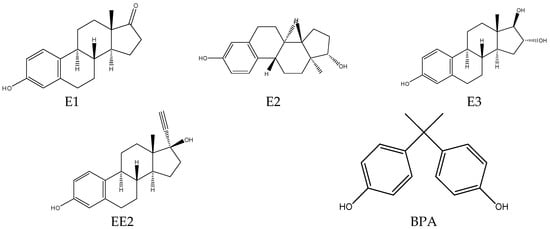
Figure 1.
Chemical structures of EDCs.
2. Materials and Methods
2.1. Chemicals and Reagents
E1, E2, E3, and BPA were purchased from Sigma-Aldrich (St. Louis, MO, USA), EE2 was obtained from Dr. Ehrenstorfer (Berlin, Germany). PVDF flat membrane (100 kDa MWCO) was chosen due to its excellent chemical resistance and thermal stability and was purchased from the Shanghai Institute of Applied Physics (Shanghai, China). Other chemical reagents were all analytical grade. O3 was provided by an O3 generator (DHXSS-1G, Jiujiu Co., Hejian, Hebei, China) with pure oxygen as the feed gas. The flow rate of the feed gas was regulated to 1 L/min and discharge voltage was 50 V.
Secondary effluent was collected from the Qinghe Municipal Wastewater Treatment Plant (Beijing, China), in which the A2/O process was applied for wastewater treatment, and the loading rate was 400,000 m3/day. Conventional water quality parameters as well as the five specific EDC concentrations were evaluated. Results are shown in Table 1. EDCs were dissolved in methanol to 1 mg/L as stock solution and was at −20 °C prior to use. The stock EDC solution was spiked into the secondary effluent to increase their concentrations to 100 μg∙L−1.

Table 1.
Water quality of secondary effluent.
2.2. Experimental Procedures
A UF unit, an O3 unit and their combination (Figure 2) were operated to investigate the removal efficiency of EDCs. For the O3 unit, the procedure is briefly described as follows: the secondary effluent containing 100 µg∙L−1 EDCs was firstly put into an O3 reaction tank, in which the O3 was generated by the O3 generator at the concentration of 5.5 mg∙L−1 react with secondary effluent. After the reaction, the high purity nitrogen was introduced to blow O3 out, which was not completely reacted, to an off-gas bottle filled with potassium iodide solution. For the UF unit, the secondary effluent containing 100 µg∙L−1 EDCs was put into the feed tank, then filtered into the UF cup by a peristaltic pump. The filter fluid was pumped into the weighing bottle on the electronic balance by another peristaltic pump. The quality of the filtrate was weighed by an electronic balance, and the data were transmitted to a computer for processing and analysis. For the combination process of O3 and UF, the secondary effluent treated by O3 was put into the feed tank, and the subsequent filtration experiment was carried out as above.
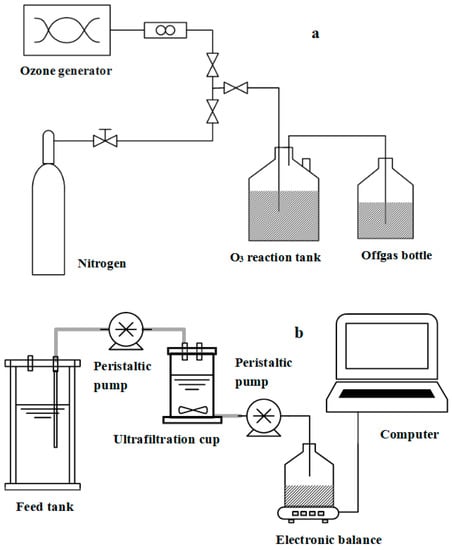
Figure 2.
Schematic diagram of ozone (a) and ultrafiltration unit (b).
2.3. Analytical Methods
Ultra-performance liquid chromatography tandem mass spectrometry (UPLC/MS/MS) was used to quantify E1, E2, E3, EE2 and BPA in the solution simultaneously on a UPLC system (Quattro Premier XE, Waters, Milford, MA, USA). The mobile phase consisted of acetonitrile (A) and ultrapure water (B); the analysis conditions are listed in Table 2. The membrane surface was observed via scanning electron microscopy (SEM) (QUANTA 200, FEI, Hillsboro, OR, USA).

Table 2.
Analysis conditions of UPLC/MS/MS.
The scanning ranges of the three-dimensional excitation-emission matrix (EEM) fluorescence spectroscope (F-7000, Hitachi, Japan) were excitation wavelength/emission wavelengths (Ex/Em) of 220–420 nm (step of 5 nm)/240–600 nm (step of 2 nm). After obtaining the fluorescence intensity corresponding to each Ex/Em, Origin8.5 was used to plot the contour map. UV-Vis spectroscopy (UV-2401PC, Shimadzu, Kyoto, Japan) was used to scan the full wavelength range of 200–400 nm. Estrogenicity was determined based on a yeast estrogenicity screening assay [19,20] and the result was expressed by the E2 equivalent concentration (EEQC). Acute ecotoxicity was assessed by determining inhibition of the luminescence of the marine Gram-negative bacterium Vibrio fischeri with a rapid screening kit (JQ TOX-kit IV) purchased from Beijing Jinda Qingchuang Environmental Technology Co., Ltd. (Haidian District, Beijing, China) [21]. The bacteria were in freeze-dried form and activated by rehydration with a reconstitution solution. The light emission wavelength at 475 nm of this bacterium in contact with different samples for 30 min was measured, and bioluminescence inhibition was calculated.
The removal efficiency of EDCs was used to evaluate the effect of O3 degradation and UF rejection of EDCs; , where R is the removal rate of EDCs, C0 is the initial concentration of EDCs, and C is the residual concentration of EDCs in the solution.
3. Results and Discussion
3.1. Effects of UF, O3, and Their Combination on Reduction of Fluorescence Intensity
Effects of O3, UF, and their combination on the three-dimensional EEM spectra of secondary effluent were investigated and the results are illustrated in Figure 3. It could be observed that the four EEM spectra exhibited similar peak information. Two main peaks could be identified from the fluorescence spectra of samples. The first main peak was located at excitation/emission wavelengths (Ex/Em) of 225–250/325–400 nm (Peak A), while the second main peak was observed at the 275–300/325–400 nm (Peak B). Peak A had been considered as aromatic protein-like substances and peak B had been considered as soluble microbial metabolites and humic acid-like substances [22]. Fluorescence intensity (FI) of peaks could be used for quantitative analysis. The fluorescence parameters of the spectra including peak location and FI were summarized in Table 3. It could be seen that FI of protein-like and humic acid-like substances were obviously lower in the combined process, indicating that lower concentrations of protein and humic acid substances were present. The result indicated that the removal efficiency of protein-like and humic acid-like substances was significantly enhanced by the combination of O3 and UF.
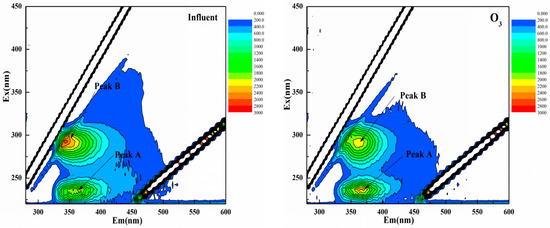
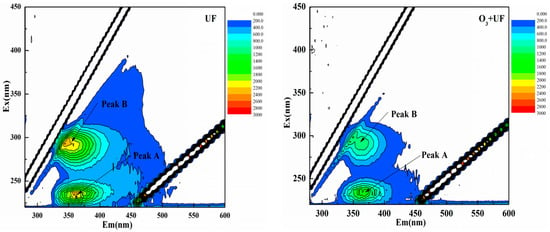
Figure 3.
EEM fluorescence spectra of secondary effluent in different processes.

Table 3.
Fluorescence spectral parameters of samples.
3.2. Effects of UF, O3, and Their Combination on Reduction of Ultraviolet Absorbance (UVA)
UVA spectrum can reflect the content of organic compounds. It has been well accepted the UVA at 254 nm (UVA254) can be considered as a parameter representing organics [23]. This is because organic compounds with multiple conjugated double bonds are strongly absorbed at 254 nm. The UVA at 258 nm (UVA258) can mainly represent aromatic unsaturated organics. The maximum absorption peak of nucleic acid is at 260 nm (UVA260), and the UVA at 280 nm (UVA280) is shown to have a relationship with aromatic substances [24]. Therefore, effects of O3, UF, and their combination on UVA254, UVA258, UVA260 and UVA280 of secondary effluent were further investigated and the results are presented in Figure 4. UVA254, UVA258, UVA260 and UVA280 of secondary effluent before treatment were 0.102, 0.098, 0.095 and 0.082, respectively. The four UVA spectra had a certain degree of decline, indicating that all these substances could be partly rejected by UF membrane and also be oxidized by O3. UF or O3 treatment alone resulted in 8%–10% or 18%–25% UVA reduction, respectively. When secondary effluent was treated by the combination of O3 and UF, about 34%–36% reduction in UVA reduction was achieved, which was 11%–18% higher than O3 treatment alone and 24%–26% higher than the UF treatment alone. Overall, the removal efficiency of organic compounds was significantly enhanced by the combination of UF and O3, which is consistent with the result of fluorescence adsorption reduction. This may be because pre-ozonation reduced the membrane fouling potential of the organic matters; therefore, the following UF membrane has more absorptive sites to retain more organic matters, thus leading to a higher removal efficiency. In addition, the membrane permeable flux during UF and O3 + UF process was measured to authenticate the conclusion. The average membrane flux in the UF and O3 + UF process was 23 L/(m2∙h) and 32.3 L/(m2∙h), respectively. The increased membrane flux indicated that pre-ozonation of secondary effluent could delay the fouling of UF membrane. Similar results were reported by Van et al. [25], who found that O3 oxidation caused a significant alleviation of membrane fouling for all investigated nanofiltration and UF membranes.
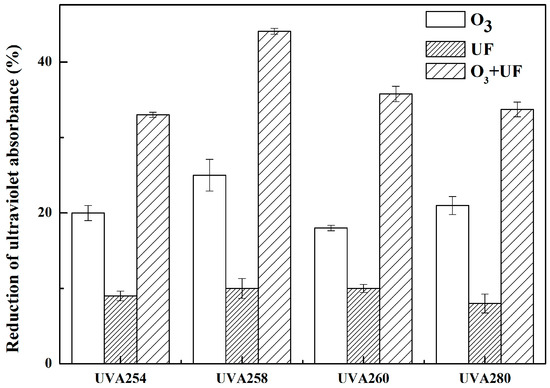
Figure 4.
Effects of ultrafiltration (UF), O3, and their combination on ultraviolet absorbance (UVA) reduction.
The photographs of used membranes after UF and O3 + UF treatment also verified the result. As shown in Figure 5, the thickness and density of the fouling layers on the membrane surface after O3 + UF treatment were obviously lower than those in the UF treatment.
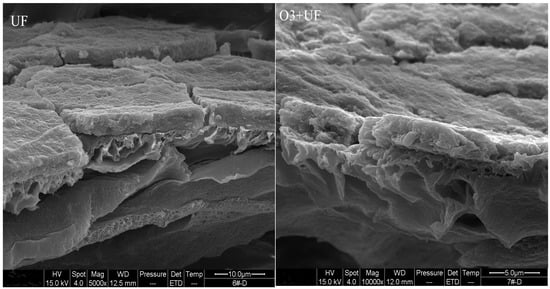
Figure 5.
Photographs of used membranes after UF and O3 + UF treatment.
Moreover, protein, carbohydrate and humic compounds are the three most important dissolved effluent organic matters (EfOM), and they account for 75% of the dissolved organic matter (DOC) according to previous studies and our survey [26]. Therefore, the contaminant removal was represented by DOC data. The relationships of DOC between UVA data and excitation emission data are shown in Figure 6 and Figure 7. It could be observed that DOC and UVA data or excitation-emission data exhibited an excellent linear relationship, indicating that UVA data and excitation emission data could reflect the content of organic compounds efficiently.

Figure 6.
The relationship of DOC and UVA.
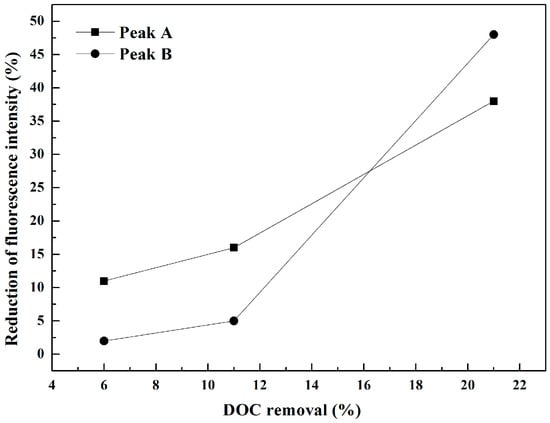
Figure 7.
The relationship of DOC and fluorescence spectral.
3.3. Effects of UF, O3, and Their Combination on EDC Removal
Effects of O3, UF, and their combination on EDC removal efficiency were investigated and the results are presented in Figure 8. UF treatment alone resulted in 8%–46% EDC removal. The mechanism of rejection was further investigated. It can be seen from the SEM photos of PVDF clean membrane that the pore size of the membrane varies from dozens to more than 100 nanometers (Figure 9), while the molecular scale of EDCs is several nanometers. The pore size of the PVDF UF membrane is much higher than that of EDCs. Therefore, the PVDF UF membrane cannot reject EDCs in theory. However, the clean membrane has a rejection rate of 8%–46% for EDCs. It can be inferred that the material layer or pore on the surface of PVDF film has physical adsorption on EDCs, which was consistent with previous research [27]. Moreover, the presence of particles in the secondary effluent and the membrane fouling can provide additional adsorption sites for the removal of EDCs. Our previous research indicated that effluent organic matters on the membrane surface enhanced EDC removal [28]. On the other hand, the results of zeta potential measurement show that the membrane surface is negatively charged, while EDCs showed electro-positivity. Therefore, the membrane can also remove EDCs by charge adsorption.
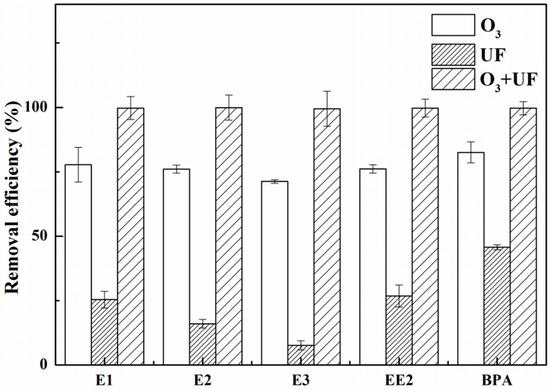
Figure 8.
Effects of ultrafiltration (UF), O3, and their combination on EDC removal.
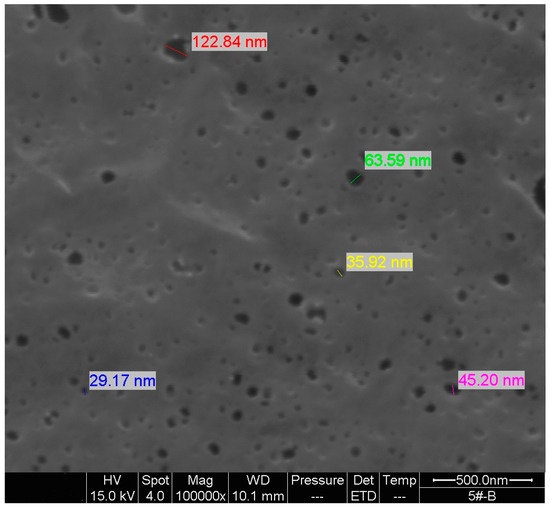
Figure 9.
SEM photos of PVDF clean membrane.
The removal rates of five EDCs were all over 70% when only O3 was used. It could be seen that O3 had obvious effect on EDC removal. Two main oxidants (molecular O3 and OH radical) may be acting in the ozonation reaction. The electronic structure of O3 results in its selective oxidation. The oxidation of organic micro-pollutants by O3 is an efficient process for compounds with functional groups containing phenols, amines and double bonds, which can be degraded into intermediates and small molecules through redox reaction, dipole addition reaction and electrophilic substitution reaction [29]. O3 is unstable in water and its active groups are transformed into OH radical, which is a strong oxidizer and ultimately oxidizes the organic compounds to small molecular compounds such as CO2 and H2O [30].
When EDCs were treated by the combination of O3 and UF, about 100% EDC removal efficiency was achieved. These data indicated that the combined treatment was much more effective in EDC removal than independent UF or O3 treatment. In the combined process, O3 played a more important role in the removal of EDCs. This might be because the UF membrane had the ability to remove EDCs only in the initial stage of adsorption, and once the adsorption was saturated, the removal of EDCs mainly depended on O3.
3.4. Effects of UF, O3, and Their Combination on Estrogenicity Removal
EDCs are not directly toxic to organisms. They indirectly affect biological properties by affecting the endocrine system of organisms. Estrogenic activity of a substance is defined as its capacity to bind to the estrogen receptor and elucidate an estrogenic response [31]. EDCs still have strong estrogenic activity even at lower concentrations. Moreover, EDCs are not completely mineralized, but transformed into a series of intermediate products by ozonation [32] and the estrogenic activity of some intermediate products is higher than that of the corresponding parent molecule, and has a higher ecological risk [33]. Therefore, the estrogenic of samples was further determined in this study. Both UF and O3 processes removed estrogenicity from raw secondary effluent to some extent (Figure 10). However, samples treated by O3 alone still had strong estrogenic activity. Bertanza et al. [34] also studied estrogenicity removal by ozonation and found ozonation alone could not significantly remove estrogenicity, giving only 20% removal efficiency. However, it is clear that the combined O3 and UF process provided better results. Lower estrogenicity can be considered to be low risk to human beings, so effluent from the O3 + UF process could be safer.
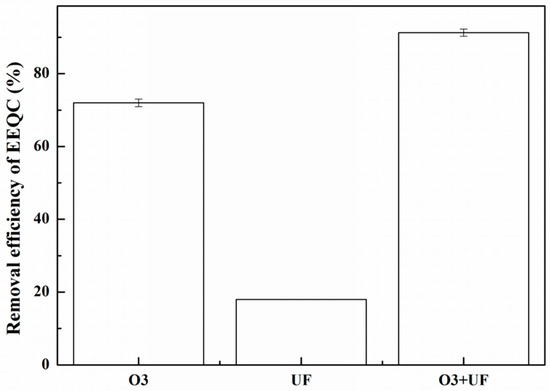
Figure 10.
Effects of ultrafiltration (UF), O3, and their combination on estrogenicity removal.
3.5. Effects of UF, O3, and Their Combination on Acute Ecotoxicity
Acute ecotoxicity of raw water and treated samples was tested by evaluating the inhibition of bioluminescence from Vibrio fischeri. As shown in Figure 11, it can be seen that the relative luminous intensity of treated samples is obviously higher than that of the raw solution spiked with EDCs. Both ozonation and the UF process-treated samples showed a reduction of toxicity. O3-UF treatment achieved the highest reduction of toxicity of the raw water; the luminescence inhibition ratio dropped to 10%.
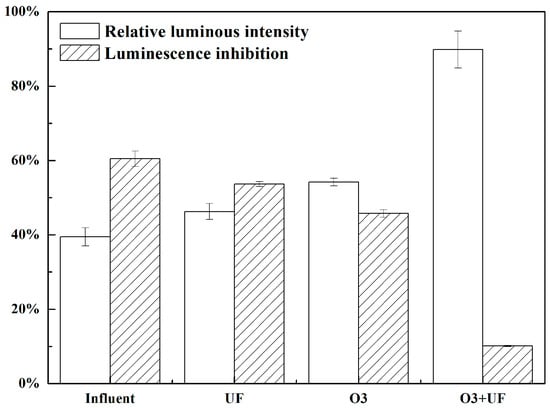
Figure 11.
Effects of ultrafiltration (UF), O3, and their combination on acute ecotoxicity.
4. Conclusions
This study investigated and compared the removal efficiency of five EDCs (E1, E2, E3, EE2 and BPA) using O3, UF and their combination. The organic matters in secondary effluent became easier to be removed by the combined process. The removal efficiency of EDC concentration, estrogenicity and acute ecotoxicity were greater than that of the O3 or UF alone. When EDCs were treated by the combination of O3 and UF, about 100% EDC removal efficiency was achieved. Moreover, O3 oxidation allows an alleviation of UF membrane fouling. Overall, the combined application of O3 and UF offers an effective approach to control the concentration and ecotoxicity of EDCs in secondary effluent.
Author Contributions
Conceptualization, X.S.; Investigation, X.S. and S.H.; Methodology, X.S.; Resources, Z.H.; Software, X.S.; Supervision, Z.H.; Validation, X.S.; Writing-original draft, X.S.
Funding
This research was funded by the “National Natural Science Foundation of China” (No. 51808008), “Natural Science Foundation of Hebei Province” (No. E2017409004) and “Langfang Science and Technology Support Program Project” (No. 2018013019).
Conflicts of Interest
The authors declare no conflict of interest.
References
- Gupta, V.K.; Ali, I.; Saleh, T.A. Chemical treatment technologies for waste-water recycling—An overview. RSC Adv. 2012, 2, 6380–6388. [Google Scholar] [CrossRef]
- Lakretz, A.; Mamane, H.; Cikurel, H. The role of soil aquifer treatment (SAT) for effective removal of organic matter, trace organic compounds and microorganisms from secondary effluents pre-treated by ozone. Ozone-Sci. Eng. 2017, 39, 385–394. [Google Scholar] [CrossRef]
- Liu, Y.H.; Zhang, S.H.; Ji, G.X. Occurrence, distribution and risk assessment of suspected endocrine-disrupting chemicals in surface water and suspended particulate matter of Yangtze River (Nanjing section). Ecotoxicol. Environ. Saf. 2017, 135, 90–97. [Google Scholar] [CrossRef] [PubMed]
- Padhye, L.P.; Yao, H.; Kung’u, F.T. Year-long evaluation on the occurrence and fate of pharmaceuticals, personal care products, and endocrine disrupting chemicals in an urban drinking water treatment plant. Water Res. 2014, 51, 266–276. [Google Scholar] [CrossRef] [PubMed]
- Song, X.; Wen, Y.; Wang, Y. Environmental risk assessment of the emerging EDCs contaminants from rural soil and aqueous sources: Analytical and modelling approaches. Chemosphere 2018, 198, 546–555. [Google Scholar] [CrossRef] [PubMed]
- Luo, Y.; Guo, W.; Ngo, H.H. A review on the occurrence of micropollutants in the aquatic environment and their fate and removal during wastewater treatment. Sci. Total Environ. 2014, 473, 619–641. [Google Scholar] [CrossRef] [PubMed]
- Prusinski, L.; Yang, Q.; Mas, A. Early-life exposure to endocrine-disrupting chemicals (EDCs) leads to the development ofuterine fibroids by impairing DNA repair capacity in myometrial stem cells. Fertil. Steril. 2016, 106, 282. [Google Scholar] [CrossRef]
- Casals-Casas, C.; Desvergne, B. Endocrine disruptors: From endocrine to metabolic disruption. Annu. Rev. Physiol. 2011, 73, 135–162. [Google Scholar] [CrossRef] [PubMed]
- Joseph, L.; Boateng, L.K.; Flora, J.R.V. Removal of bisphenol A and 17α-ethinyl estradiol by combined coagulation and adsorption using carbon nanomaterials and powdered activated carbon. Sep. Purif. Technol. 2013, 107, 37–47. [Google Scholar] [CrossRef]
- Ben Fredj, S.; Novakoski, R.T.; Tizaoui, C. Two-phase ozonation for the removal of estrone, 17β-estradiol and 17α-ethinylestradiol in water using ozone-loaded decamethylcyclopentasiloxane. Ozone-Sci. Eng. 2017, 39, 343–356. [Google Scholar] [CrossRef]
- Basile, T.; Petrella, A.; Petrella, M. Review of endocrine-disrupting-compound removal technologies in water and wastewater treatment plants: An EU perspective. Ind. Eng. Chem. Res. 2011, 50, 8389–8401. [Google Scholar] [CrossRef]
- Jin, P.K.; Jin, X.; Wang, X.C.C.; Shi, X.B. An analysis of the chemical safety of secondary effluent for reuse purposes and the requirement for advanced treatment. Chemosphere 2013, 91, 558–562. [Google Scholar] [CrossRef] [PubMed]
- Shon, H.K.; Vigneswaran, S.; Snyder, S.A. Effluent organic matter (EfOM) in wastewater: Constituents, effects, and treatment. Crit. Rev. Environ. Sci. Technol. 2006, 36, 327–374. [Google Scholar] [CrossRef]
- Zhang, H.; Yamada, H.; Tsuno, H. Removal of endocrine-disrupting chemicals during ozonation of municipal sewage with brominated byproducts control. Environ. Sci. Technol. 2008, 42, 3375–3380. [Google Scholar] [CrossRef] [PubMed]
- Yu, W.; Graham, N.J.D.; Fowler, G.D. Coagulation and oxidation for controlling ultrafiltration membrane fouling in drinking water treatment: Application of ozone at low dose in submerged membrane tank. Water Res. 2016, 95, 1–10. [Google Scholar] [CrossRef] [PubMed]
- Chang, T.C.; Pan, Y.W.; Chen, S.S. Removal of natural organic matter (NOM) using ozonation and ultrafiltration. Water Sci. 2001, 1, 49–54. [Google Scholar] [CrossRef]
- Chang, H.S.; Choo, K.H.; Lee, B. The methods of identification, analysis, and removal of endocrine disrupting compounds (EDCs) in water. J. Hazard. Mater. 2009, 172, 1–12. [Google Scholar] [CrossRef] [PubMed]
- Wert, E.C.; Rosario-Ortiz, F.L.; Snyder, S.A. Using ultraviolet absorbance and color to assess pharmaceutical oxidation during ozonation of wastewater. Environ. Sci. Technol. 2009, 43, 4858–4863. [Google Scholar] [CrossRef] [PubMed]
- Metcalfe, C.D.; Metcalfe, T.L.; Kiparissis, Y. Estrogenic potency of chemicals detected in sewage treatment plant effluents as determined by in vivo assays with Japanese medaka (Oryzias latipes). Environ. Toxicol. Chem. 2001, 20, 297–308. [Google Scholar] [CrossRef] [PubMed]
- Rutishauser, B.V.; Pesonen, M.; Escher, B.I. Comparative analysis of estrogenic activity in sewage treatment plant effluents involving three in vitro assays and chemical analysis of steroids. Environ. Toxicol. Chem. 2004, 23, 857–864. [Google Scholar] [CrossRef] [PubMed]
- Kudłak, B.; Wieczerzak, M.; Yotova, G. Environmental risk assessment of Polish wastewater treatment plant activity. Chemosphere 2016, 160, 181–188. [Google Scholar] [CrossRef] [PubMed]
- Sgroi, M.; Roccaro, P.; Korshin, G.V. Monitoring the behavior of emerging contaminants in wastewater-impacted rivers based on the use of fluorescence excitation emission matrixes (EEM). Environ. Sci. Technol. 2017, 51, 4306–4316. [Google Scholar] [CrossRef] [PubMed]
- Peleato, N.M.; Legge, R.L.; Andrews, R.C. Neural networks for dimensionality reduction of fluorescence spectra and prediction of drinking water disinfection by-products. Water Res. 2018, 136, 84–94. [Google Scholar] [CrossRef] [PubMed]
- Cong, Y.; Wang, Z.; He, S. Multifunctional single-drug loaded nanoparticles for enhanced cancer treatment with low toxicity in vivo. RSC Adv. 2016, 6, 20366–20373. [Google Scholar] [CrossRef]
- Meng, F.; Drews, A.; Mehrez, R.; Iversen, V.; Ernst, M.; Yang, F.; Jekel, M.; Kraume, M. Occurrence, source, and fate of dissolved organic matter (DOM) in a pilot-scale membrane bioreactor. Environ. Sci. Technol. 2009, 43, 8821–8826. [Google Scholar] [CrossRef] [PubMed]
- Van Geluwe, S.; Vinckier, C.; Braeken, L. Ozone oxidation of nanofiltration concentrates alleviates membrane fouling in drinking water industry. J. Membrane Sci. 2011, 378, 128–137. [Google Scholar] [CrossRef]
- Liu, Z.H.; Kanjo, Y.; Mizutani, S. Removal mechanisms for endocrine disrupting compounds (EDCs) in wastewater treatment—physical means, biodegradation, and chemical advanced oxidation: A review. Sci. Total Environ. 2009, 407, 731–748. [Google Scholar] [CrossRef] [PubMed]
- Si, X.; Hu, Z.; Ding, D. Effects of effluent organic matters on endocrine disrupting chemical removal by ultrafiltration and ozonation in synthetic secondary effluent. J. Environ. Sci. 2018. [Google Scholar] [CrossRef]
- Von Gunten, U. Ozonation of drinking water: Part I. Oxidation kinetics and product formation. Water Res. 2003, 37, 1443–1467. [Google Scholar] [CrossRef]
- Petrella, A.; Mascolo, G.; Murgolo, S.; Petruzzelli, V.; Ranieri, E.; Spasiano, D.; Petruzzelli, D. Photocatalytic oxidation of organic micro-pollutants: Pilot plant investigation and mechanistic aspects of the degradation reaction. Chem. Eng. Commun. 2016, 203, 1298–1307. [Google Scholar] [CrossRef]
- Maniero, M.G.; Bila, D.M.; Dezotti, M. Degradation and estrogenic activity removal of 17β-estradiol and 17α-ethinylestradiol by ozonation and O3/H2O2. Sci. Total Environ. 2008, 407, 105–115. [Google Scholar] [PubMed]
- Akbari, S.; Ghanbari, F.; Moradi, M. Bisphenol A degradation in aqueous solutions by electrogenerated ferrous ion activated ozone, hydrogen peroxide and persulfate: Applying low current density for oxidation mechanism. Chem. Eng. J. 2016, 294, 298–307. [Google Scholar] [CrossRef]
- Carlson, J.C.; Stefan, M.I.; Parnis, J.M. Direct UV photolysis of selected pharmaceuticals, personal care products and endocrine disruptors in aqueous solution. Water Res. 2015, 84, 350–361. [Google Scholar] [CrossRef] [PubMed]
- Bertanza, G.; Papa, M.; Pedrazzani, R. EDCs, estrogenicity and genotoxicity reduction in a mixed (domestic+ textile) secondary effluent by means of ozonation: A full-scale experience. Sci. Total Environ. 2013, 458, 160–168. [Google Scholar] [CrossRef] [PubMed]
© 2018 by the authors. Licensee MDPI, Basel, Switzerland. This article is an open access article distributed under the terms and conditions of the Creative Commons Attribution (CC BY) license (http://creativecommons.org/licenses/by/4.0/).